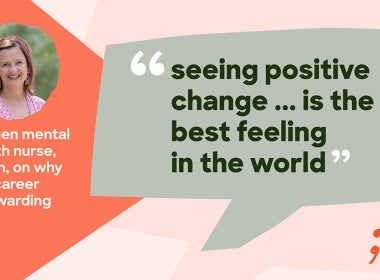
How to improve mental health in schools
Approximately one in seven (14 per cent) Australian children and adolescents aged four to 17 are estimated to have experienced a mental illness in their lifetime. And in the wake of the pandemic’s disruption and heightened stress, that figure—and the toll on mental health in schools—is expected to rise.
According to the Mental Health Journal of Australia, the mental health of young Australians is rapidly declining—so much so that it’s been called a public health crisis. Unfortunately, when we consider the weight of exams, the complexities of peer relationships and overall challenges of the digital age, there’s no mystery as to why.
But all hope is not lost. Schools hold a unique position not just as academic hubs, but as impactful spaces to nurture and fortify the mental wellbeing of our young people. From developing and implementing mental health programs in schools to appointing qualified practitioners, there are a number of strategies that can bolster mental health in schools.
Here, we explore some practical ways schools can promote mental health literacy in students, along with relevant challenges to consider in their effective implementation.
Mental health in schools: The current landscape
The state of mental health in schools needs attention. According to the Mission Australia Youth Survey 2022 Report, mental health is one of the top three most important issues to youth in Australia today. More than a third (38.5 per cent) of young people were extremely or very concerned about mental health.
The report also found that a staggering 41.5 per cent of students said their biggest personal challenges were school challenges—including academic pressure, high workload, challenges with teachers, learning difficulties and general school challenges. Mental health challenges—including low mental health, stress, anxiety, depression, low self-esteem or self-harm—were the second-most prevalent at 27.7 per cent.
The solutions suggested by young people included diversifying or increasing the number of mental health programs in schools and implementing better support systems to manage future crises (e.g., pandemics) and cope with the effects.
The impact of COVID-19 on our youth’s mental health has been well documented. A study published in Pediatrics found the spike in hospital youth mental health presentations only declined slightly after restrictions eased and remains high today. Mental health issues have been referred to as the “second wave” of health problems stemming from the pandemic.
In response, evidence-based mental health and wellbeing programs are being promoted at both a state and national government level, including through Australia’s first National Children’s Mental Health and Wellbeing Strategy. The strategy was developed to provide a framework to establish foundations for lifelong mental health and wellbeing in childhood.
But every school and its students are different. To see the level of impact required, a targeted approach—including increased support, programs and mental health practitioners in schools—is needed.
7 ways to promote better mental health in schools
While not every institution will have the resources to hire an education mental health practitioner or completely rewrite the curriculum, there are a number of ways teachers and mental health professionals can promote better health in schools. Deciding which program components and delivery is best for your school community will depend on a number of considerations, including time needed for engagement, budgets, governance and partnership, and—of course—your students’ needs.
From peer support groups to mental health practitioners in schools, here are some of the strategies to bolster the emotional wellbeing of students in your care.
Increase awareness of mental health in classrooms
When implementing any kind of mental health program in schools, it’s essential to first promote awareness and understanding of the issue and its importance—for teachers, students and parents alike. There are a number of ways to do this, depending on your school’s current awareness of mental health in classrooms.
Schoolwide initiatives and activities that inform and equip teachers with the skillset to identify signs of mental health issues in their students is a good place to start. In practice, this can look like implementing prevention programs, hosting workshops, seminars or guest speakers events to educate the school community about mental health issues and decreasing stigma around seeking help.
Organisations like ReachOut Schools provide a number of resources and practical frameworks to guide educators, parents and students. Promoting awareness amongst students and parents is essential—family and community play a vital role in the prevention and management of youth mental health issues.
Train teachers and educators in mental health
Teachers and educators spend a great deal of time with students in both peer and academic settings, thus are often best placed to notice if a student exhibits signs of mental health issues.
Where there are no resources to appoint specialised mental health practitioners in a school, upskilling teachers is even more important. While there are hundreds of mental health disorders, most fall into core categories including:
- mood disorders such as depression and bipolar disorder
- anxiety
- personality disorders
- schizophrenia
- eating disorders
- trauma-related disorders
- substance abuse disorders
To identify these disorders in a busy class setting, teachers must know what to look for.
State governments provide mental health training resources for educators. If you want to give your students the best care, higher education programs like a Master of Child and Adolescent Mental Health provide students with the specialist skills needed to improve mental health and wellbeing for our young generation.
Ongoing monitoring of student mental health needs
Supporting mental health from early childhood right through to early adulthood can’t be achieved with a “one-and-done” approach; it requires ongoing monitoring, development and support. Creating an advisory board within the school to consult on and continually monitor the school’s mental health landscape can be a highly effective way to achieve this.
Implementing check-in strategies such as mental health screenings with regular questionnaires—for students, parents and teachers—along with anonymous reporting systems and wellness programs are also effective strategies. If you’re ever in doubt, collaborating with local mental health services is a great place to start.
Offer accessible services for students
For many young people, the accessibility of mental health services can be a huge barrier to gaining the specialised support required. The Mental Health Commission found only half (51.1 per cent) of children with a mental illness have seen a health professional in the last 12 months and 40 per cent of children with a mental illness used or attended services provided by their school for emotional and behavioural struggles.
Ensuring students feel safe and able to access these services is a significant step toward better mental health in schools. These services can include:
- a specialised education mental health practitioner within the school
- collaboration with external mental health support services
- 24/7 crisis hotlines or text-based services
- anonymous reporting systems where students can report concerns about their own mental health or the mental health of others
- peer support programs
Peer support programs
Community and a sense of belonging are increasingly being recognised as an important determinant of health. Peer support groups can be a highly effective way to not only nurture a sense of community, but allow students to seek help in an environment they feel comfortable in.
Peer support programs can involve older students supporting younger peers, or students of the same age-group supporting each other as they encounter similar academic stressors and social experiences.
Organisations like Peer Support Australia can provide schools with the professional development, support and guidance to design and implement effective peer support initiatives.
Foster inclusive environments
A sense of belonging is an inherent human need and a significant factor in mental health and wellbeing. According to Mission Australia’s Social Exclusion and the Mental Health of Young People report, 60 per cent of young people have experienced social exclusion in at least one aspect of their life (such as their housing, education and financial resources) and 25 per cent have experienced it in multiple aspects.
Fostering inclusive environments in schools can involve:
- establishing a clear inclusion policy that outlines the school’s commitment to diversity and equity
- providing ongoing training and professional development for teachers and all school staff on topics related to diversity, equity and inclusion
- developing and implementing a diverse curriculum to ensure it reflects diverse perspectives, cultures and experiences
- offering inclusive extracurricular activities and clubs that cater to diverse talents and interests—ensuring they’re welcoming to all students
- celebrating diversity at every opportunity, including LGBTQIA+ Pride, cultural heritage months, disability awareness events and other occasions that celebrate diversity
Prioritise physical activity and nutrition while managing academic stress
Almost half (46 per cent) of Australian students feel extremely or very stressed about study and exams, which can lead to depression, poor sleep, substance abuse and anxiety.
Positive physical health is an essential component of positive mental health. Exercise has been shown to reduce anxiety and depression by boosting self-esteem and cognitive function. Similarly, diets high in fruit, vegetables, wholegrains and fibre and low in processed foods and sugary drinks are associated with strong mental health. It’s important for schools to offer a well-balanced curriculum that emphasises physical activities and not just academic achievement, and provide nutritious foods on campus while encouraging parents to do the same.
Make a difference for children and adolescents
More than ever, young people need support and practical strategies to nurture and improve their mental health as they progress through our education system. The demand for professionals in this space has never been greater. With the right training, teachers and mental health practitioners are better positioned to develop and implement the evidence-based strategies our youth needs to thrive.
VU Online’s Master of Child and Adolescent Mental Health is a unique fully online program designed around the working professional with dedicated seven-day-a-week academic support provided by qualified experts in the field. Designed for the world we want to see, it equips students with the work-based knowledge, skills and advanced care strategies needed to drive positive impact in schools and beyond.
Interested in making a truly profound difference for the upcoming generation? Speak to a Student Enrolment Advisor today and find a flexible learning path that works for you, or check out our website for more information.
-
View previous article
 The role of a travel nurse27 September 2023
The role of a travel nurse27 September 2023 -
View next article
 10 reasons why working in youth mental health is rewarding26 October 2023
10 reasons why working in youth mental health is rewarding26 October 2023

